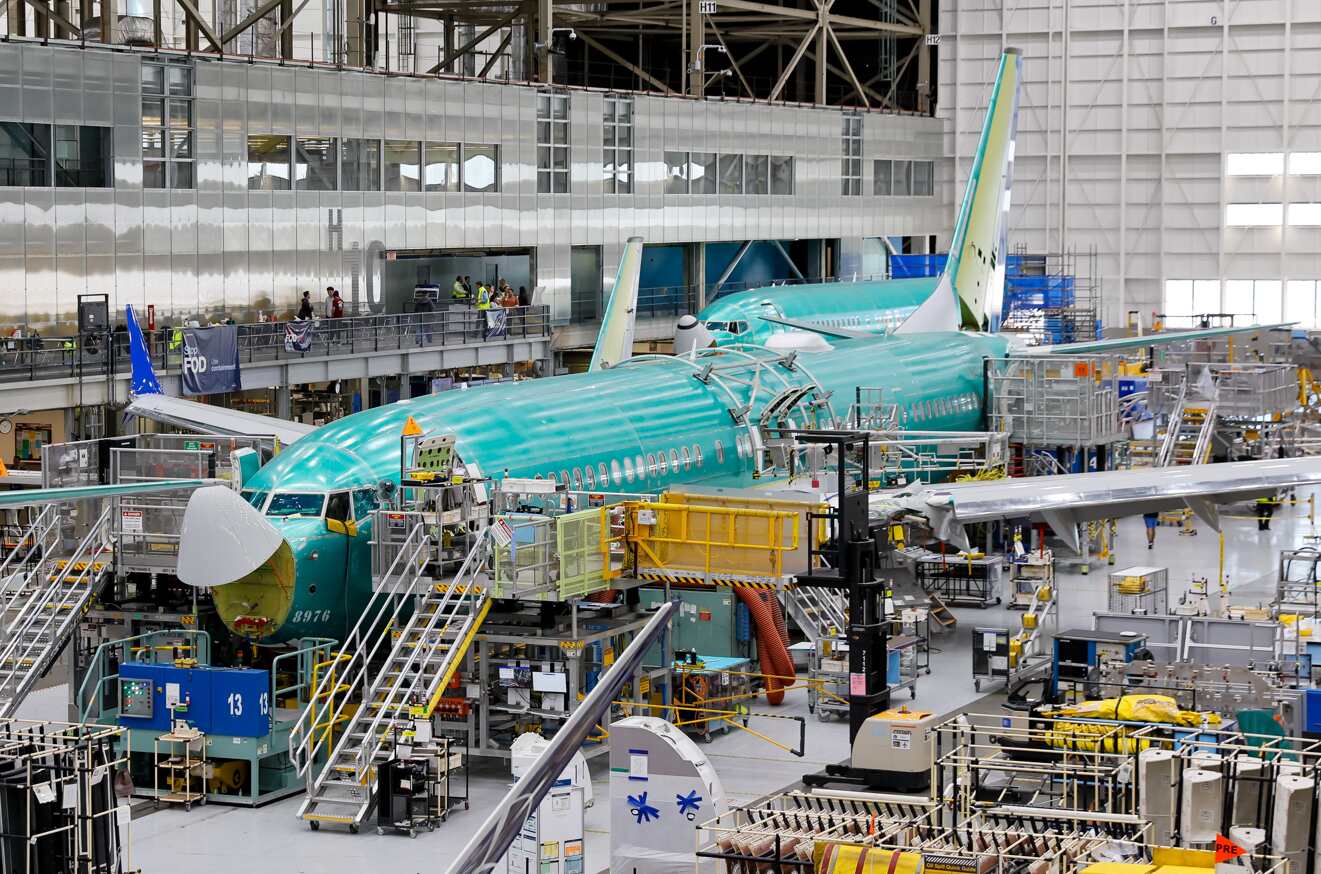Boeing 737 MAX aircraft are assembled at the Boeing Renton Factory in Renton, Washington, on June 25, 2024. Image by Jennifer Buchanan / POOL / AFP Boeing is bringing production of its plane fuselages back in-house. The aerospace giant announced early Monday it had agreed to acquire its largest supplier, Spirit AeroSystems, in an $8.3 billion deal, including debt, 19 years after it had spun out the operation. It may be the best of bad options for the embattled companies, industry experts told Forbes, but it will take Boeing years to straighten out the money-losing supplier and the quality problems that have bedeviled both of them.
“This is a lot like two drunk guys at a bar saying I'm too drunk to drive home,” said Cliff Collier, an aerospace consultant. “And then one of them says, ‘I know, we'll get in the same car and go together.’ This is not going to solve either company's problems.”
Improving Spirit operations and integrating them with Boeing’s will be complicated, and Boeing executives have to do so while absorbed with a host of other problems. Chief among them is manufacturing quality: In January, a panel made by Spirit blew out of a Boeing 737 Max operated by Alaska airlines mid-flight, prompting scrutiny by regulators. A federal investigation into the accident preliminarily found that the panel had been removed at a Boeing factory to fix rivets that had been misinstalled by Spirit workers, and then put back in place without four retaining bolts.
It’s unclear that Boeing’s current management has a solid grip on how to improve quality, some say. “It's not like Boeing has a world-class operating system that they can just drop in on Spirit. Boeing's operating system has the same problem Spirit’s does,” said Collier.
CEO David Calhoun touted the deal Monday as “one of the most significant” the company has taken to strengthen quality. “This is an opportunity to bring back critical airplane manufacturing work on Boeing airplanes into our factories – where Boeing and Spirit world-class engineers and mechanics can work seamlessly together, focused on a common mission to build safe and quality airplanes for our customers.”
In 2005, as part of a campaign to outsource parts production for its planes, Boeing sold off to private equity the factory in Wichita, Kansas, that built the fuselages for the 737, its best-selling plane, as well as body parts of other aircraft. Spirit expanded to make structures for other companies, most notably Airbus, but it struggled to build a sustainable business. Most aerospace suppliers make fat profits from selling spare parts for repairs, something that isn’t a possibility with fuselages because they’re expected to last the life of the aircraft.
Spirit’s financial position worsened when Boeing halted production of the 737 Max in January 2020 after two deadly crashes in the previous two years. Then the Covid pandemic froze aircraft demand more broadly. But Spirit has had to carry the expense of maintaining capacity for higher production rates than Boeing could take. By 2023, Boeing was forced to inject cash into Spirit to keep it afloat.
As part of the deal, Airbus will also be paid $559 million to take over unprofitable units of Spirit that make parts for the European planemaker.
There may be some cost savings from combining the two companies. If Spirit were producing at a full rate of 50 737 fuselages a month, instead of around 30 now, it could earn a profit of roughly $1.5 million on each, Melius Research estimates. Eliminating that markup would save Boeing $900 million a year.
But it will be hard to find synergies in their supply chains, said Collier. And it will take time for Boeing to switch Spirit over to its systems for managing day-to-day operations and HR. Meanwhile Spirit machinists’ collective bargaining agreement, which is based on Spirit’s current operating methods and runs until June 2027, will make it harder for Boeing to harmonize how their factories run.
“To some degree Boeing's going to have to be hands off for a couple years because it's too hard to try to integrate them right now,” said Collier. “But then you ask yourself, okay, then how's Boeing fixing Spirit?”
Green Workers, Red Ink One of the key problems at Spirit, Boeing and the broader aerospace sector, observers say, is a deep loss of experience on the assembly line during the pandemic, when companies shed tens of thousands of workers amid a deep freeze in aviation.
Amid a strong rebound in the manufacturing job market nationwide, aerospace companies only got 20% to 30% of furloughed workers to come back, analyst Scott Mikus of Melius Research estimates, compared to 70% to 80% in prior downturns.
Boeing has expanded its training for new employees, but even the best training is only the start in building airplanes, said Collier. The production rates of planes are low compared to cell phones or cars, so aerospace assembly workers aren’t doing the same repetitive tasks many times a day like their compatriots at higher-volume manufacturers, he said, and tend to perform a broader range of work with more tools. “It still takes a couple of years to really get good at assembly in aerospace, no matter what you do [in initial training],” Collier said.
Experience is particularly important on the 737 Max, the latest version of a plane that debuted in the 1960s. It’s largely handmade, with Spirit and Boeing workers manually drilling and filling hundreds of thousands of holes. Misdrilled holes have been flagged on more 737 Max planes than just the Alaska model.
Spirit CEO Pat Shanahan has touted adding more automation on the assembly line as the key. “That is the fundamental solution to zero defects,” he said on an earnings call in February.
Automation will help to an extent, but it will take time and only go so far, observers say. “It’ll be a multi-year thing” to get the machines from manufacturers and integrate them into Spirit’s operations, said Mikus.
The antiquated nature of the 737 will limit how much of the work can be turned over to industrial robots, said Collier. “You're probably doing good to get 60% automated. So you’ve still got to drill tens of thousands of holes.”
Boeing will now also be saddled with supporting Spirit’s suppliers, who are also struggling after investing to raise production rates at Boeing’s behest, only to be stuck with idle capacity as the plane maker has struggled to follow through on its plans.
“If they could turn on the Max machine and get to [40 or 50 planes per month], none of these cash issues would be a problem,” said Richard Aboulafia, a managing director at AeroDynamic Advisory. “It's just a giant self-inflicted wound.”
Boeing has a slate of its own problems. Its board is searching for a new CEO to replace Calhoun, who has pledged to exit by the end of the year. (Spirit CEO Shanahan, who used to work at Boeing, is believed to be a candidate.) The U.S. Department of Justice is reportedly set to bring fraud charges against the company after determining it violated the terms of a 2021 deferred prosecution agreement over the two Max crashes. And the union that represents its assembly workers in Washington State has scheduled a vote for next month to authorize leadership to call a strike amid negotiations for a new contract. (If Boeing’s machinists in Washington state win a fat contract, that could spark discontent among Spirit workers over the terms of their deal, points out Collier.)
At Spirit, separating the operations that Airbus will take over is a complicated headache of its own. Meanwhile, Spirit has built up a defense business that makes structures for Boeing competitors – most notably the fuselage of the in-development B-21 bomber for Northrop Grumman. It’s possible that defense companies will have concerns about Boeing gaining access to their intellectual property, said Mikus.
However, Aboulafia said a change in leadership to executives focused more on manufacturing than financial results could go a long way to helping Boeing solve its problems.
The C-suite failures at Boeing “paradoxically fills me with hope,” he said. “If you have leaders that show up in factories and are engaged in the actual business of building and designing planes, it can get much better very fast.”













